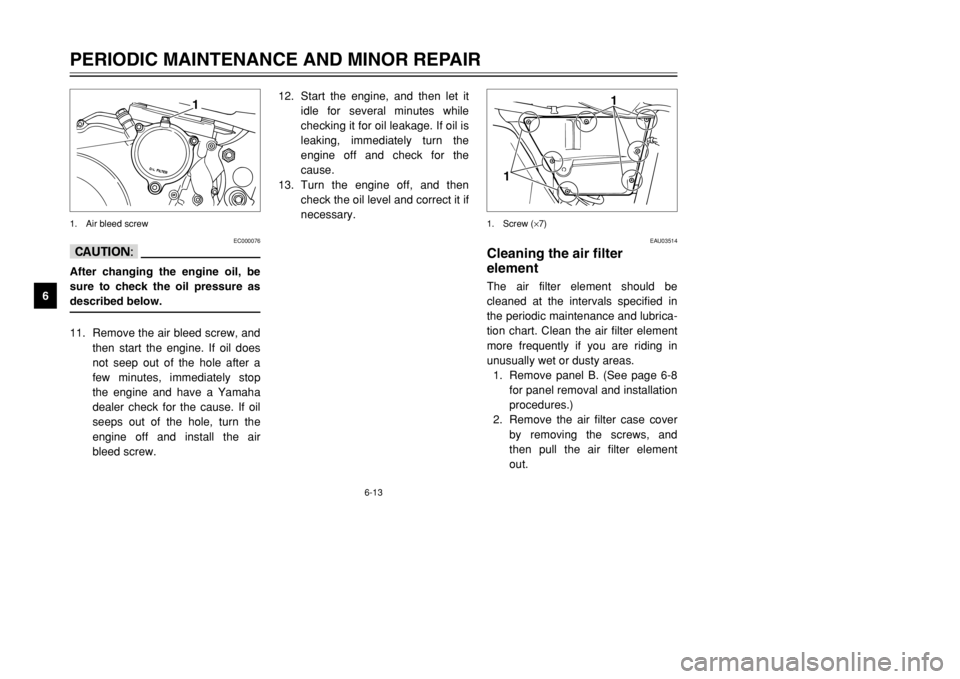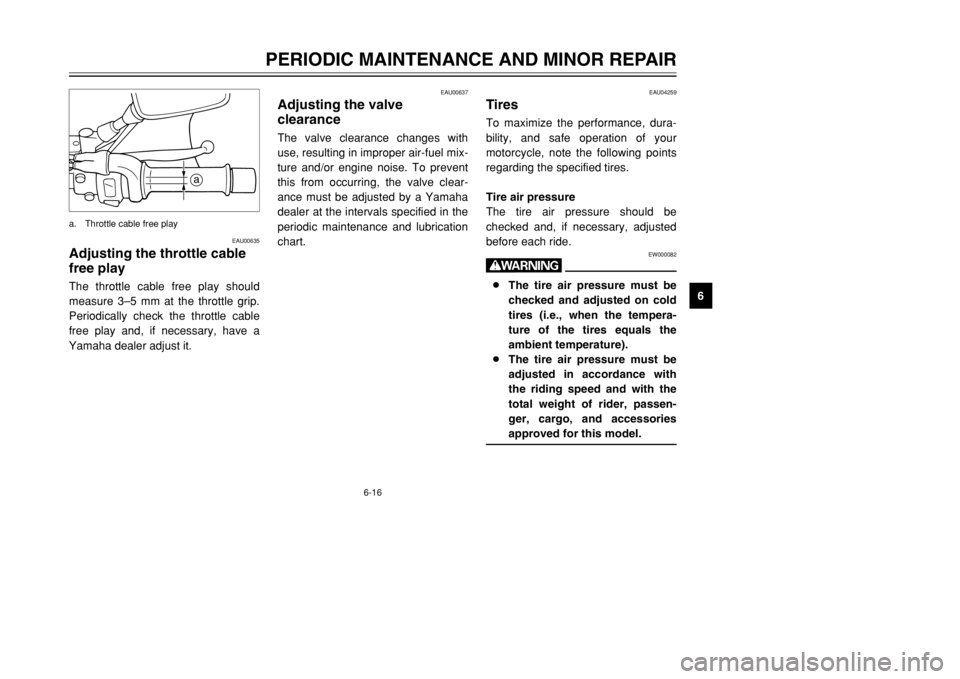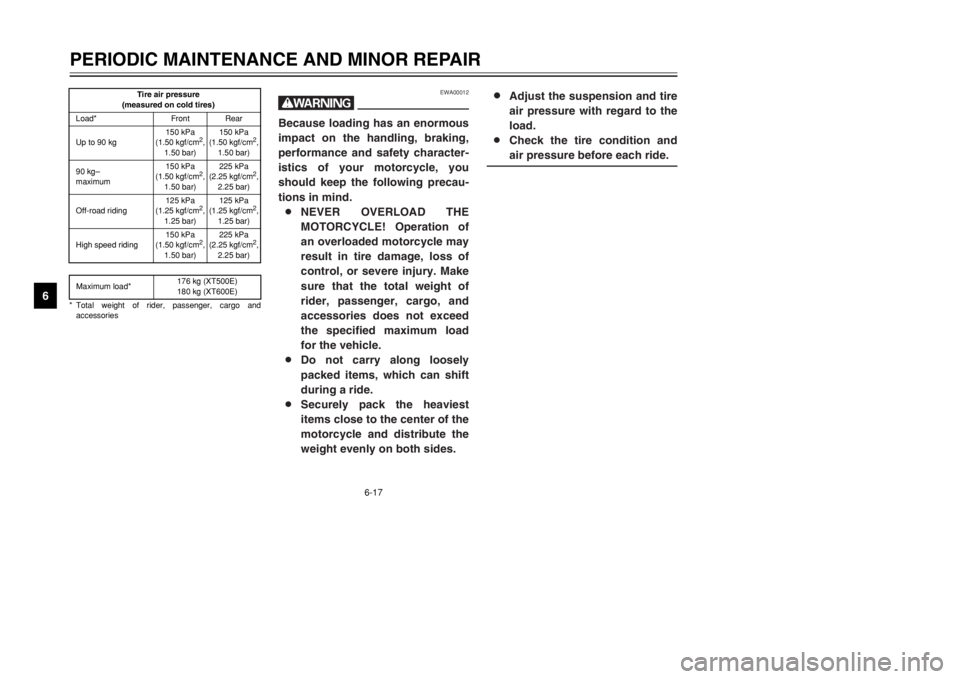YAMAHA XT600E 2002 Workshop Manual
Manufacturer: YAMAHA, Model Year: 2002, Model line: XT600E, Model: YAMAHA XT600E 2002Pages: 100, PDF Size: 2.1 MB
Page 51 of 100

6-13
PERIODIC MAINTENANCE AND MINOR REPAIR
6
EC000076
cCAfter changing the engine oil, be
sure to check the oil pressure as
described below.11. Remove the air bleed screw, and
then start the engine. If oil does
not seep out of the hole after a
few minutes, immediately stop
the engine and have a Yamaha
dealer check for the cause. If oil
seeps out of the hole, turn the
engine off and install the air
bleed screw.12. Start the engine, and then let it
idle for several minutes while
checking it for oil leakage. If oil is
leaking, immediately turn the
engine off and check for the
cause.
13. Turn the engine off, and then
check the oil level and correct it if
necessary.
1
1. Air bleed screw
EAU03514
Cleaning the air filter
elementAir filter element, cleaningThe air filter element should be
cleaned at the intervals specified in
the periodic maintenance and lubrica-
tion chart. Clean the air filter element
more frequently if you are riding in
unusually wet or dusty areas.
1. Remove panel B. (See page 6-8
for panel removal and installation
procedures.)
2. Remove the air filter case cover
by removing the screws, and
then pull the air filter element
out.
1
1
1. Screw (×7)
4PT-E7 (English) 6/29/01 9:13 AM Page 50
Page 52 of 100

6-14
PERIODIC MAINTENANCE AND MINOR REPAIR
6 3. Lightly tap the air filter element to
remove most of the dust and dirt,
and then blow the remaining dirt
out with compressed air as
shown. If the air filter element is
damaged, replace it.
4. Insert the air filter element into
the air filter case with the arrow
mark on the top pointing inward.
EAU00629
Adjusting the carburetorCarburetor, adjustingThe carburetor is an important part of
the engine and requires very sophisti-
cated adjustment. Therefore, most
carburetor adjustments should be left
to a Yamaha dealer, who has the
necessary professional knowledge
and experience. The adjustment
described in the following section,
however, may be serviced by the
owner as part of routine mainte-
nance.
EC000094
cCThe carburetor has been set and
extensively tested at the Yamaha
factory. Changing these settings
without sufficient technical knowl-
edge may result in poor perfor-
mance of or damage to the engine.
1
1. Mesh side
EC000082
cC8Make sure that the air filter ele-
ment is properly seated in the
air filter case.
8The engine should never be
operated without the air filter
element installed, otherwise
the piston and/or cylinder may
become excessively worn.5. Install the air filter case cover by
installing the screws.
6. Install the panel.
1
1. Arrow mark
4PT-E7 (English) 6/29/01 9:13 AM Page 51
Page 53 of 100

6-15
PERIODIC MAINTENANCE AND MINOR REPAIR
6
EAU00632
Adjusting the engine idling
speedEngine idling speedThe engine idling speed must be
checked and, if necessary, adjusted
as follows at the intervals specified in
the periodic maintenance and lubrica-
tion chart.
1. Start the engine and warm it up
for several minutes at 1,000–
2,000 r/min while occasionally
revving it to 4,000–5,000 r/min.NOTE:
The engine is warm when it quickly
responds to the throttle.
NOTE:
If the specified idling speed cannot
be obtained as described above,
have a Yamaha dealer make the
adjustment.
2. Check the engine idling speed
and, if necessary, adjust it to
specification by turning the throt-
tle stop screw. To increase the
engine idling speed, turn the
screw in direction a. To
decrease the engine idling
speed, turn the screw in direction
b.
1
b
a
1. Throttle stop screw
Engine idling speed:
1,200–1,400 r/min
(Except for CH)
1,300–1,400 r/min
(For CH)
4PT-E7 (English) 6/29/01 9:13 AM Page 52
Page 54 of 100

6-16
PERIODIC MAINTENANCE AND MINOR REPAIR
6
EAU00635
Adjusting the throttle cable
free playThrottle cable free play, adjustingThe throttle cable free play should
measure 3–5 mm at the throttle grip.
Periodically check the throttle cable
free play and, if necessary, have a
Yamaha dealer adjust it.
a
a. Throttle cable free play
EAU04259
TiresTiresTo maximize the performance, dura-
bility, and safe operation of your
motorcycle, note the following points
regarding the specified tires.
Tire air pressure
The tire air pressure should be
checked and, if necessary, adjusted
before each ride.
EW000082
w8The tire air pressure must be
checked and adjusted on cold
tires (i.e., when the tempera-
ture of the tires equals the
ambient temperature).
8The tire air pressure must be
adjusted in accordance with
the riding speed and with the
total weight of rider, passen-
ger, cargo, and accessories
approved for this model.
EAU00637
Adjusting the valve
clearanceValve clearance, adjustingThe valve clearance changes with
use, resulting in improper air-fuel mix-
ture and/or engine noise. To prevent
this from occurring, the valve clear-
ance must be adjusted by a Yamaha
dealer at the intervals specified in the
periodic maintenance and lubrication
chart.
4PT-E7 (English) 6/29/01 9:13 AM Page 53
Page 55 of 100

6-17
PERIODIC MAINTENANCE AND MINOR REPAIR
68 8
Adjust the suspension and tire
air pressure with regard to the
load.
8Check the tire condition and
air pressure before each ride.
EWA00012
wBecause loading has an enormous
impact on the handling, braking,
performance and safety character-
istics of your motorcycle, you
should keep the following precau-
tions in mind.
8NEVER OVERLOAD THE
MOTORCYCLE! Operation of
an overloaded motorcycle may
result in tire damage, loss of
control, or severe injury. Make
sure that the total weight of
rider, passenger, cargo, and
accessories does not exceed
the specified maximum load
for the vehicle.
8Do not carry along loosely
packed items, which can shift
during a ride.
8Securely pack the heaviest
items close to the center of the
motorcycle and distribute the
weight evenly on both sides.
Tire air pressure
(measured on cold tires)
Load* Front Rear
Up to 90 kg150 kPa
(1.50 kgf/cm
2,
1.50 bar)150 kPa
(1.50 kgf/cm
2,
1.50 bar)
90 kg–
maximum150 kPa
(1.50 kgf/cm
2,
1.50 bar)225 kPa
(2.25 kgf/cm
2,
2.25 bar)
Off-road riding125 kPa
(1.25 kgf/cm
2,
1.25 bar)125 kPa
(1.25 kgf/cm
2,
1.25 bar)
High speed riding150 kPa
(1.50 kgf/cm
2,
1.50 bar)225 kPa
(2.25 kgf/cm
2,
2.25 bar)
Maximum load*176 kg (XT500E)
180 kg (XT600E)
* Total weight of rider, passenger, cargo and
accessories
4PT-E7 (English) 6/29/01 9:13 AM Page 54
Page 56 of 100

6-18
PERIODIC MAINTENANCE AND MINOR REPAIR
6 Tire inspection
The tires must be checked before
each ride. If the center tread depth
reaches the specified limit, if the tire
has a nail or glass fragments in it, or
if the sidewall is cracked, have a
Yamaha dealer replace the tire imme-
diately.
a
1
1. Side wall
a. Tire tread depth
EW000078
w8The front and rear tires should
be of the same make and
design, otherwise the handling
characteristics of the motorcy-
cle cannot be guaranteed.
8After extensive tests, only the
tires listed below have been
approved for this model by
Yamaha Motor Co., Ltd.
NOTE:
The tire tread depth limits may differ
from country to country. Always com-
ply with the local regulations.Tire information
This motorcycle is equipped with tube
tires.
Minimum tire tread depth
(front and rear)1.6 mm
FRONT
Manufacturer Size TypeBRIDGESTONE
90/90-21 54S
TW47
90/90-21 M/C 54S
DUNLOP
90/90-21 54S
TRAIL MAX L
90/90-21 M/C 54S
REAR
Manufacturer Size Type
BRIDGESTONE
120/90-17 64S
TW48
120/90-17 M/C 64S
DUNLOP120/90-17 64S
TRAIL MAX
120/90-17 M/C 64S
4PT-E7 (English) 6/29/01 9:13 AM Page 55
Page 57 of 100

6-19
PERIODIC MAINTENANCE AND MINOR REPAIR
6
EAU00681
w8Have a Yamaha dealer replace
excessively worn tires.
Besides being illegal, operat-
ing the motorcycle with exces-
sively worn tires decreases
riding stability and can lead to
loss of control.
8The replacement of all wheel-
and brake-related parts,
including the tires, should be
left to a Yamaha dealer, who
has the necessary profession-
al knowledge and experience.
8It is not recommended to
patch a punctured tube. If
unavoidable, however, patch
the tube very carefully and
replace it as soon as possible
with a high-quality product.
8Ride at moderate speeds after
changing a tire since the tire sur-
face must first be “broken in” for
it to develop its optimal charac-
teristics.
EAU00685
Spoke wheelsWheelsTo maximize the performance, dura-
bility, and safe operation of your
motorcycle, note the following points
regarding the specified wheels.
8The wheel rims should be
checked for cracks, bends or
warpage, and the spokes for
looseness or damage before
each ride. If any damage is
found, have a Yamaha dealer
replace the wheel. Do not
attempt even the smallest repair
to the wheel. A deformed or
cracked wheel must be replaced.
8The wheel should be balanced
whenever either the tire or wheel
has been changed or replaced.
An unbalanced wheel can result
in poor performance, adverse
handling characteristics, and a
shortened tire life.
4PT-E7 (English) 6/29/01 9:13 AM Page 56
Page 58 of 100

6-20
PERIODIC MAINTENANCE AND MINOR REPAIR
6
EAU00694
Adjusting the clutch lever
free playClutch lever free play, adjustingThe clutch lever free play should
measure 10–15 mm as shown.
Periodically check the clutch lever
free play and, if necessary, adjust it
as follows.
1. Loosen the locknut at the clutch
lever.
2. To increase the clutch lever free
play, turn the adjusting bolt in
direction a. To decrease the
clutch lever free play, turn the
adjusting bolt in direction b.
a
b 12
c1. Locknut (clutch lever)
2. Adjusting bolt
c. Free play
7. Tighten the locknut at the clutch
lever and the crankcase.
3. If the specified clutch lever free
play could be obtained as
described above, tighten the
locknut and skip the rest of the
procedure, otherwise proceed as
follows.
4. Fully turn the adjusting bolt at the
clutch lever in direction ato
loosen the clutch cable.
5. Loosen the locknut at the
crankcase.
6. To increase the clutch lever free
play, turn the adjusting nut in
direction a. To decrease the
clutch lever free play, turn the
adjusting nut in direction b.
b
a
2
1
1. Locknut (crankcase)
2. Adjusting nut
4PT-E7 (English) 6/29/01 9:13 AM Page 57
Page 59 of 100

6-21
PERIODIC MAINTENANCE AND MINOR REPAIR
6
EAU00696
Adjusting the brake lever
free playBrake lever free play, adjustingThe brake lever free play should
measure 2–5 mm as shown.
Periodically check the brake lever
free play and, if necessary, adjust it
as follows.
1. Loosen the locknut at the brake
lever.
2. To increase the brake lever free
play, turn the adjusting bolt in
direction a. To decrease the
brake lever free play, turn the
adjusting bolt in direction b.
1
2b
a
c
1. Locknut
2. Adjusting bolt
c. Free play
EAU00712
Adjusting the brake pedal
positionBrake pedal position, adjustingThe top of the brake pedal should be
positioned approximately 12 mm
below the top of the footrest as
shown. Periodically check the brake
pedal position and, if necessary,
have a Yamaha dealer adjust it.
a
a. Brake pedal position
3. Tighten the locknut.
EW000099
w8After adjusting the brake lever
free play, check the free play
and make sure that the brake
is working properly.
8A soft or spongy feeling in the
brake lever can indicate the
presence of air in the
hydraulic system. If there is air
in the hydraulic system, have
a Yamaha dealer bleed the
system before operating the
motorcycle. Air in the
hydraulic system will diminish
the braking performance,
which may result in loss of
control and an accident.
4PT-E7 (English) 6/29/01 9:13 AM Page 58
Page 60 of 100

6-22
PERIODIC MAINTENANCE AND MINOR REPAIR
6
EW000109
wA soft or spongy feeling in the
brake pedal can indicate the pres-
ence of air in the hydraulic system.
If there is air in the hydraulic sys-
tem, have a Yamaha dealer bleed
the system before operating the
motorcycle. Air in the hydraulic
system will diminish the braking
performance, which may result in
loss of control and an accident.
EAU00721
Checking the front and rear
brake padsFront and rear brake pads, checkingThe front and rear brake pads must
be checked for wear at the intervals
specified in the periodic maintenance
and lubrication chart.
EAU00713
Adjusting the rear brake light
switchRear brake light switch, adjustingThe rear brake light switch, which is
activated by the brake pedal, is prop-
erly adjusted when the brake light
comes on just before braking takes
effect. If necessary, adjust the brake
light switch as follows.
Turn the adjusting nut while holding
the rear brake light switch in place.
To make the brake light come on ear-
lier, turn the adjusting nut in direction
a. To make the brake light come on
later, turn the adjusting nut in direc-
tion b.
21
a
b
1. Rear brake light switch
2. Adjusting nut
4PT-E7 (English) 6/29/01 9:13 AM Page 59